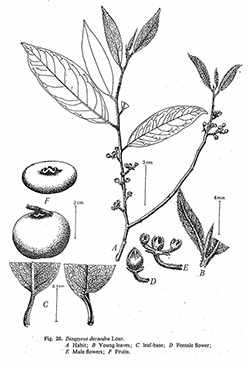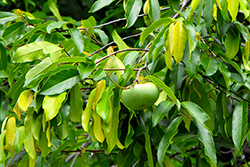e-Flora of Thailand
Volume 2 > Part 4 > Year 1981 > Page 321 > Ebenaceae > Diospyros
20. Diospyros decandra Lour.wfo-0000648759
Fl. Cochinch. 1: 227. 1790; Hiern, Trans. Camb. Phil.Soc. 12.1: 160. 1873; Lecomte in Fl. Gén. I.-C. 3: 961. 1930; Merr., Trans. Amer. Phil. Soc. NS 24(2): 302. 1955. Fig. 20.
Accepted Name : This is currently accepted.
Synonyms & Citations :
Description : Evergreen tree, up to 20 m high; young twigs villous, unarmed. Leaves (elliptic-)oblong, 7–10 by 2.5–3 cm, base obtuse or acute, apex acute or acuminate, chartaceous, villous then glabrescent; secondary nerves 7–8 pairs, 70° to midrib, arched but not anastomosing, inconspicuous on both surfaces; reticulation inconspicuous on both surfaces; petiole 3–5 mm long, villous later glabrescent. Male flowers cymose, 5-merous; pedicel 2–4 mm long, villous. Calyx campanulate, 4–7 mm long, divided ± to the base, villous on both sides. Corolla urceolate, 10–15 mm long, divided to an eighth or a quarter, villous later glabrescent on both sides. Stamens 14–18, glabrous. Rudimentary ovary glabrous. Female flowers solitary, 5-merous; pedicel 3–5 mm long, villous. Calyx and Corolla as in male flowers but larger. Ovary ovoid, woolly, 5-locular; styles 2, woolly. Staminodes 9, glabrous. Fruit globose, 3–4 by 4–5 cm, succulent and fragrant when ripe, glabrous, rounded to strongly impressed at both ends; fruiting calyx divided to the base, tomentose on both sides; lobes reflexed, not undulate nor plicate, without nerves; fruit-stalk ± 5 mm long; endosperm smooth.
Thailand : Cultivated as an ornamental and shade tree throughout the country.
Distribution : S China, Vietnam (Tonkin – type), India, Burma, Laos.
Vernacular : Chan (จัน), chan o (จันโอ), chan in (จันอิน).
Uses: Ripe fruit yellow, fragrant, edible with sweet taste.


